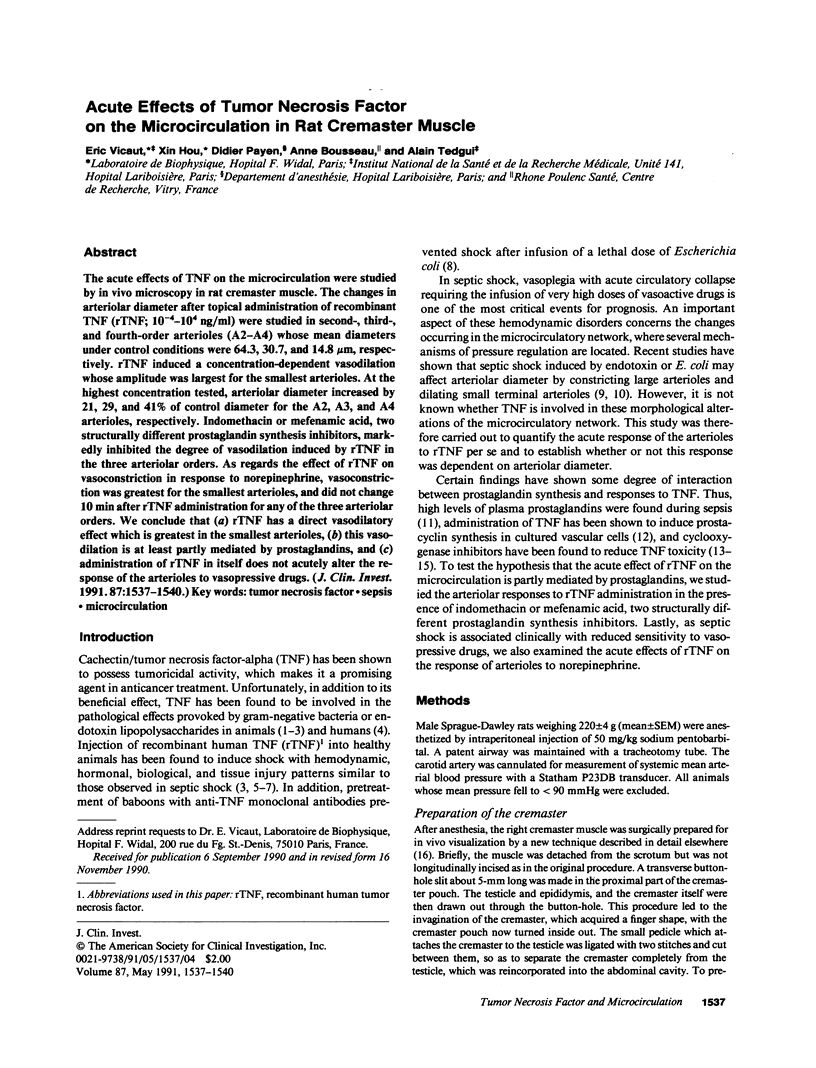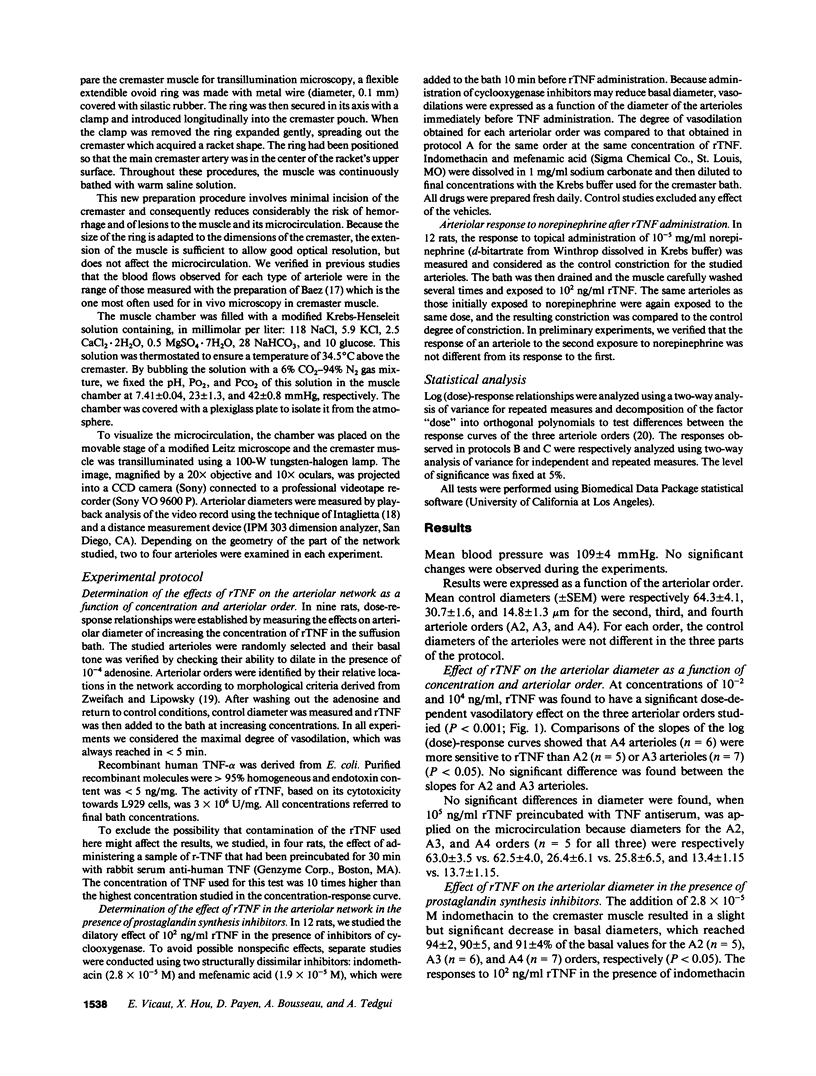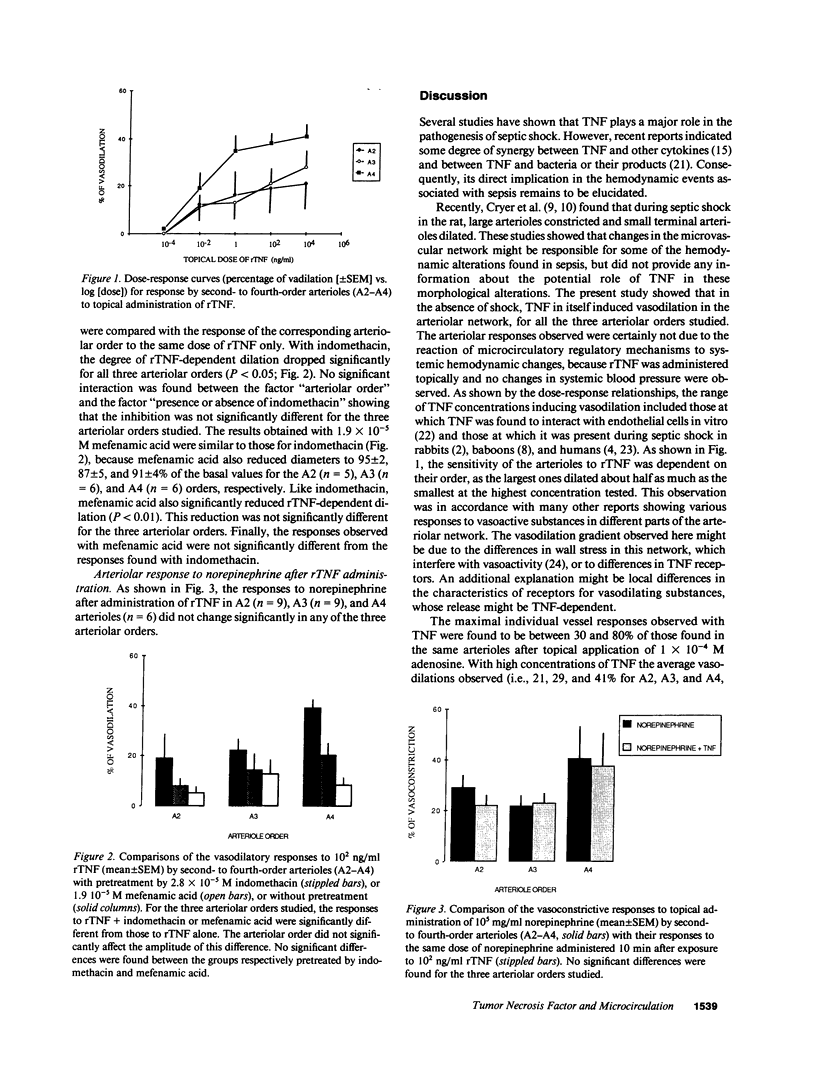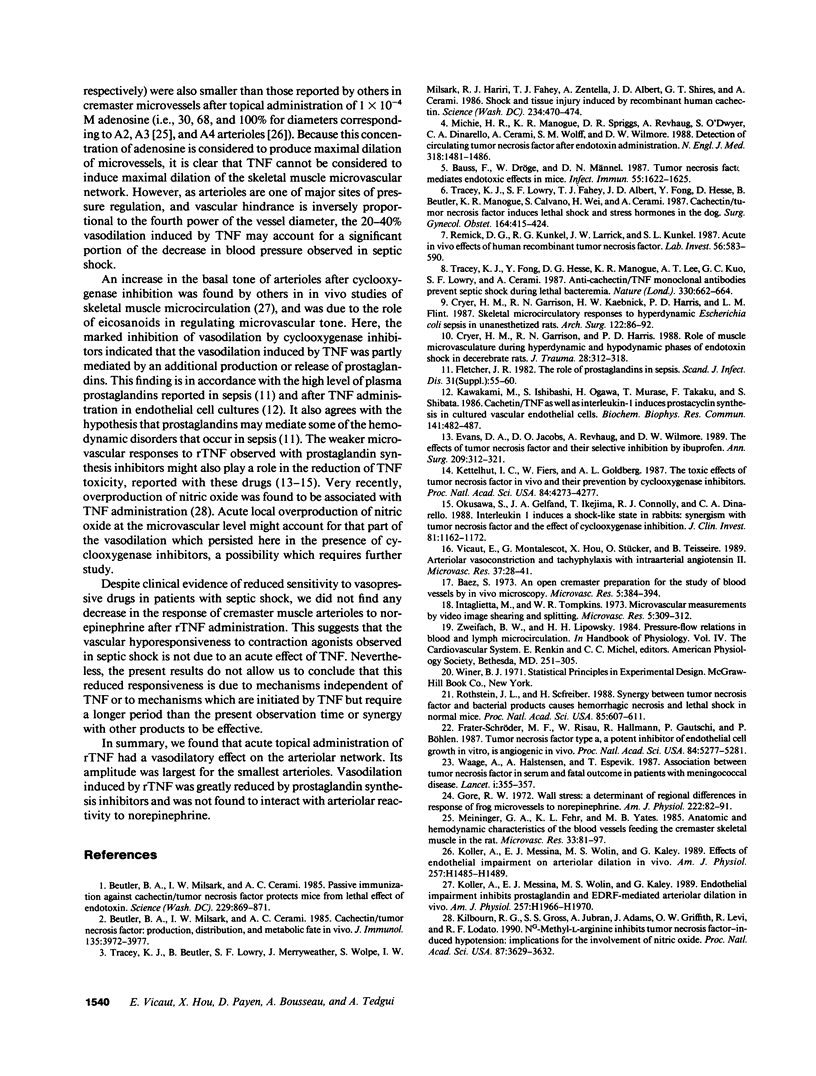Abstract
The acute effects of TNF on the microcirculation were studied by in vivo microscopy in rat cremaster muscle. The changes in arteriolar diameter after topical administration of recombinant TNF (rTNF; 10(-4)-10(4) ng/ml) were studied in second-, third-, and fourth-order arterioles (A2-A4) whose mean diameters under control conditions were 64.3, 30.7, and 14.8 microns respectively. rTNF induced a concentration-dependent vasodilation whose amplitude was largest for the smallest arterioles. At the highest concentration tested, arteriolar diameter increased by 21, 29, and 41% of control diameter for the A2, A3, and A4 arterioles, respectively. Indomethacin or mefenamic acid, two structurally different prostaglandin synthesis inhibitors, markedly inhibited the degree of vasodilation induced by rTNF in the three arteriolar orders. As regards the effect of rTNF on vasoconstriction in response to norepinephrine, vasoconstriction was greatest for the smallest arterioles, and did not change 10 min after rTNF administration for any of the three arteriolar orders. We conclude that (a) rTNF has a direct vasodilatory effect which is greatest in the smallest arterioles, (b) this vasodilation is at least partly mediated by prostaglandins, and (c) administration of rTNF in itself does not acutely alter the response of the arterioles to vasopressive drugs.
Full text
PDF



Images in this article
Selected References
These references are in PubMed. This may not be the complete list of references from this article.
- Baez S. An open cremaster muscle preparation for the study of blood vessels by in vivo microscopy. Microvasc Res. 1973 May;5(3):384–394. doi: 10.1016/0026-2862(73)90054-x. [DOI] [PubMed] [Google Scholar]
- Bauss F., Dröge W., Männel D. N. Tumor necrosis factor mediates endotoxic effects in mice. Infect Immun. 1987 Jul;55(7):1622–1625. doi: 10.1128/iai.55.7.1622-1625.1987. [DOI] [PMC free article] [PubMed] [Google Scholar]
- Beutler B. A., Milsark I. W., Cerami A. Cachectin/tumor necrosis factor: production, distribution, and metabolic fate in vivo. J Immunol. 1985 Dec;135(6):3972–3977. [PubMed] [Google Scholar]
- Beutler B., Milsark I. W., Cerami A. C. Passive immunization against cachectin/tumor necrosis factor protects mice from lethal effect of endotoxin. Science. 1985 Aug 30;229(4716):869–871. doi: 10.1126/science.3895437. [DOI] [PubMed] [Google Scholar]
- Cryer H. M., Garrison R. N., Harris P. D. Role of muscle microvasculature during hyperdynamic and hypodynamic phases of endotoxin shock in decerebrate rats. J Trauma. 1988 Mar;28(3):312–318. doi: 10.1097/00005373-198803000-00006. [DOI] [PubMed] [Google Scholar]
- Cryer H. M., Garrison R. N., Kaebnick H. W., Harris P. D., Flint L. M. Skeletal microcirculatory responses to hyperdynamic Escherichia coli sepsis in unanesthetized rats. Arch Surg. 1987 Jan;122(1):86–92. doi: 10.1001/archsurg.1987.01400130092014. [DOI] [PubMed] [Google Scholar]
- Evans D. A., Jacobs D. O., Revhaug A., Wilmore D. W. The effects of tumor necrosis factor and their selective inhibition by ibuprofen. Ann Surg. 1989 Mar;209(3):312–321. doi: 10.1097/00000658-198903000-00011. [DOI] [PMC free article] [PubMed] [Google Scholar]
- Fletcher J. R. The role of prostaglandins in sepsis. Scand J Infect Dis Suppl. 1982;31:55–60. [PubMed] [Google Scholar]
- Fràter-Schröder M., Risau W., Hallmann R., Gautschi P., Böhlen P. Tumor necrosis factor type alpha, a potent inhibitor of endothelial cell growth in vitro, is angiogenic in vivo. Proc Natl Acad Sci U S A. 1987 Aug;84(15):5277–5281. doi: 10.1073/pnas.84.15.5277. [DOI] [PMC free article] [PubMed] [Google Scholar]
- Gore R. W. Wall stress: a determinant of regional differences in response of frog microvessels to norepinephrine. Am J Physiol. 1972 Jan;222(1):82–91. doi: 10.1152/ajplegacy.1972.222.1.82. [DOI] [PubMed] [Google Scholar]
- Intaglietta M., Tompkins W. R. Microvascular measurements by video image shearing and splitting. Microvasc Res. 1973 May;5(3):309–312. doi: 10.1016/0026-2862(73)90042-3. [DOI] [PubMed] [Google Scholar]
- Kawakami M., Ishibashi S., Ogawa H., Murase T., Takaku F., Shibata S. Cachectin/TNF as well as interleukin-1 induces prostacyclin synthesis in cultured vascular endothelial cells. Biochem Biophys Res Commun. 1986 Dec 15;141(2):482–487. doi: 10.1016/s0006-291x(86)80198-x. [DOI] [PubMed] [Google Scholar]
- Kettelhut I. C., Fiers W., Goldberg A. L. The toxic effects of tumor necrosis factor in vivo and their prevention by cyclooxygenase inhibitors. Proc Natl Acad Sci U S A. 1987 Jun;84(12):4273–4277. doi: 10.1073/pnas.84.12.4273. [DOI] [PMC free article] [PubMed] [Google Scholar]
- Kilbourn R. G., Gross S. S., Jubran A., Adams J., Griffith O. W., Levi R., Lodato R. F. NG-methyl-L-arginine inhibits tumor necrosis factor-induced hypotension: implications for the involvement of nitric oxide. Proc Natl Acad Sci U S A. 1990 May;87(9):3629–3632. doi: 10.1073/pnas.87.9.3629. [DOI] [PMC free article] [PubMed] [Google Scholar]
- Koller A., Messina E. J., Wolin M. S., Kaley G. Endothelial impairment inhibits prostaglandin and EDRF-mediated arteriolar dilation in vivo. Am J Physiol. 1989 Dec;257(6 Pt 2):H1966–H1970. doi: 10.1152/ajpheart.1989.257.6.H1966. [DOI] [PubMed] [Google Scholar]
- Meininger G. A., Fehr K. L., Yates M. B. Anatomic and hemodynamic characteristics of the blood vessels feeding the cremaster skeletal muscle in the rat. Microvasc Res. 1987 Jan;33(1):81–97. doi: 10.1016/0026-2862(87)90009-4. [DOI] [PubMed] [Google Scholar]
- Michie H. R., Manogue K. R., Spriggs D. R., Revhaug A., O'Dwyer S., Dinarello C. A., Cerami A., Wolff S. M., Wilmore D. W. Detection of circulating tumor necrosis factor after endotoxin administration. N Engl J Med. 1988 Jun 9;318(23):1481–1486. doi: 10.1056/NEJM198806093182301. [DOI] [PubMed] [Google Scholar]
- Okusawa S., Gelfand J. A., Ikejima T., Connolly R. J., Dinarello C. A. Interleukin 1 induces a shock-like state in rabbits. Synergism with tumor necrosis factor and the effect of cyclooxygenase inhibition. J Clin Invest. 1988 Apr;81(4):1162–1172. doi: 10.1172/JCI113431. [DOI] [PMC free article] [PubMed] [Google Scholar]
- Remick D. G., Kunkel R. G., Larrick J. W., Kunkel S. L. Acute in vivo effects of human recombinant tumor necrosis factor. Lab Invest. 1987 Jun;56(6):583–590. [PubMed] [Google Scholar]
- Rothstein J. L., Schreiber H. Synergy between tumor necrosis factor and bacterial products causes hemorrhagic necrosis and lethal shock in normal mice. Proc Natl Acad Sci U S A. 1988 Jan;85(2):607–611. doi: 10.1073/pnas.85.2.607. [DOI] [PMC free article] [PubMed] [Google Scholar]
- Tracey K. J., Beutler B., Lowry S. F., Merryweather J., Wolpe S., Milsark I. W., Hariri R. J., Fahey T. J., 3rd, Zentella A., Albert J. D. Shock and tissue injury induced by recombinant human cachectin. Science. 1986 Oct 24;234(4775):470–474. doi: 10.1126/science.3764421. [DOI] [PubMed] [Google Scholar]
- Tracey K. J., Fong Y., Hesse D. G., Manogue K. R., Lee A. T., Kuo G. C., Lowry S. F., Cerami A. Anti-cachectin/TNF monoclonal antibodies prevent septic shock during lethal bacteraemia. Nature. 1987 Dec 17;330(6149):662–664. doi: 10.1038/330662a0. [DOI] [PubMed] [Google Scholar]
- Tracey K. J., Lowry S. F., Fahey T. J., 3rd, Albert J. D., Fong Y., Hesse D., Beutler B., Manogue K. R., Calvano S., Wei H. Cachectin/tumor necrosis factor induces lethal shock and stress hormone responses in the dog. Surg Gynecol Obstet. 1987 May;164(5):415–422. [PubMed] [Google Scholar]
- Vicaut E., Montalescot G., Hou X., Stucker O., Teisseire B. Arteriolar vasoconstriction and tachyphylaxis with intraarterial angiotensin II. Microvasc Res. 1989 Jan;37(1):28–41. doi: 10.1016/0026-2862(89)90070-8. [DOI] [PubMed] [Google Scholar]
- Waage A., Halstensen A., Espevik T. Association between tumour necrosis factor in serum and fatal outcome in patients with meningococcal disease. Lancet. 1987 Feb 14;1(8529):355–357. doi: 10.1016/s0140-6736(87)91728-4. [DOI] [PubMed] [Google Scholar]




